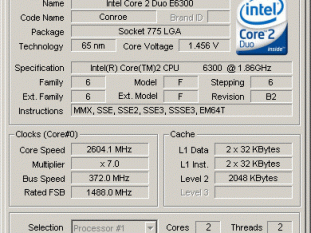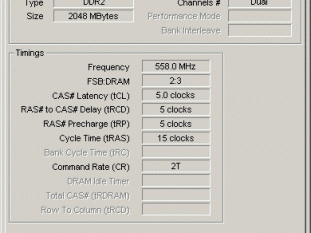Specifications
- Part number: takeMS RMS2GB264C08x-105xx
- Type: TakeMS Mach2 ddr2-1066 MHz (2*1Gb kit)
- Speed: DDR2-1066 MHz
- Density: 64Mb * 8 chips, double sided / 16 ICs – DDR2 SDRAM
- Timings: 5-5-5-15 default 800 MHz – 1.8v;
- EPP0: 5-5-5-18 1066 MHz – 1.8v;
- EPP1 3-3-3-8 800 Mhz – 2.2v
- Voltage: 1.8 V (default speed)
- 100% Jedec compatibility
- New thermal design and takeMS heatspreader for better cooling
- 6-layer PCB technology
- Standard UDIMM form factor (133.35 mm * 30.0 mm)
- NVIDIA SLI memory certification
- Operating temperature 0C ~ 55C
- Warranty: 10 years
So finally we’ve reached the part with some action, and that’s of course inserting these modules in pc to see how they perform in everyday’s work and also benchmarks. They were inserted in dual-channel mode and have worked without any problem during my four weeks of testing.
It goes for the most fun part of this article – overclocking! While the modules that I’ve tested before from takeMS – DDR2-800 MHz worked flawlessly the only negative comment that I had was its overclocking capabilities!
The modules were able to handle about 10% of overclocking, so at the end I couldn’t recommend them to computer enthusiasts. I must admit that I had a pretty large dose of prejudice in my head when I’ve received these modules.
But I definitely was wrong about these modules the minute I’ve started testing them when they were not working on their default frequency. So after I was able to easily boot them on 800 MHz with 4-4-4-12 latencies and 1066 MHz working on 5-5-5-15 latencies.
What I thought that overclocking would be boring procedure, I was totally wrong! Firstly I started to raise FSB and (which automatically increases CPU and RAM frequency on Asus motherboards) with increments of 1.
It started to become REALLY boooooring and when I’ve finally reached 300 FSB I saw that this could take ages to complete this article. So I’ve decided to increase FSB with increments of 5… and AGAIN I was amazed how with its overclocking abilities. I had to increase steps to 10, and finally I have encountered some problems with FSB 360.
I was so relieved since I thought that these modules will be 100% overclockable :-) But just when I’ve thought I’ve reached the final frequency – but I’ve easily bypassed this problem by increasing CPU Vcore to 1.425. But this time I was unable to boot my computer with FSB set to 380!
At this point I was glad that I’ve reached some limit at overclocking!!! I knew that I’ll find the right frequency between 360-380 FSB. With memory frequency set to 800 MHz (memory ratio 2:3) and CPU Vcore to 1.5125 I’ve finally reached the last stable value – FSB 372, which means 558 MHz memory frequency – multiplied by two equals the final 1116 MHz memory frequency! So at the end of this overclocking test it wasn’t that much easy to find out the maximum overclocking settings, since I’ve changed the FSB frequency and memory and CPU voltage about 30-40 times!
My Asus motherboard has really a great feature called C.P.R (CPU Parameter Recall) and the procedure work o.k. when I pushed the memory over its limits. But sometimes I’ve crossed the line of moderate overclocking so the motherboard refused to power up, and I didn’t have any other option but to remove physically BIOS chip from motherboard.
At the end of this overclocking part I would once again like to repeat myself that these are results of some moderate overclocking of memory modules. You should know that my RAM and CPU got REALLY hot during their work as overclocked components. And both of them had additional cooling, but forget the fact that CPU and RAM worked 40% faster than their default and recommended speed!
I’m just under the impression that 372 FSB is not the last limit which I’ve reached during my overclocking test, since I had success with booting my machine to windows with 380 FSB and even 385 FSB, but I was unable to complete any test for stability testing (like Prime95, Orthos and OCCT). With some additional water-cooling I’m sure that I would accomplish stable and higher memory frequencies then 1116 Mhz.


